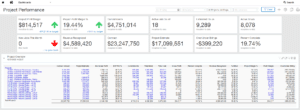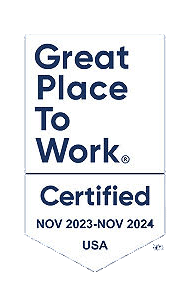
Construction companies often rely on metrics to monitor business performance, and the best way to measure success is through key performance indicators (KPIs). KPIs are utilized to measure the performance of a project compared to its objectives and goals. Tracking KPIs can help construction companies achieve long-term resilience while also meeting short-term project goals. A construction specific accounting system, like Sage Intacct, has the ability to calculate these key metrics that will ultimately help improve operational efficiency. Below are 6 essential KPIs for construction companies to help monitor and enhance business performance:

1. Percentage of Completion Method
The percentage of completion method is a method of accounting for long–term projects in which revenue and expenses are recognized based on the percentage of work they have completed during that period. This accounting method is very common amongst construction companies, as it recognizes income and profit as the project progresses, not just when the project is complete. By measuring the percentage of completion for projects, your business can gain a more accurate view of long-term financial status.
Percentage of Completion Calculation: (Total Costs to Date)/ (Total Project Estimate)
2. Revenue Recognized
Revenue recognized utilizes the same percentage of completion formula. Depending on the nature of your construction business, you can calculate revenue recognition based off variables other than cost, such as units, labor hours, etc. Sage Intacct Construction has the capability to make these calculations and handle the reporting of revenue as determined by various metrics. With the ability to run Work in Progress reports in Sage Intacct, you can correctly bill clients on time and ensure that your business is accurately recognizing revenue.
Revenue Recognized Calculation: (Percentage of Completion) x (Contract Amount)
3. Over and Under Billing
Construction companies often struggle to maintain cash flow. Over and under billing is usually shown on the balance sheet as a liability account, Billings in Excess of Costs, or as an asset account, Costs in Excess of Billings. The calculation is total billings less revenue earned. If it has been overbilled, then it is a liability; if it is underbilled there is an asset. With Sage Intacct Construction, you can allocate an over and under billing column to accurately forecast when cash will come in.
Over and Under Billing Calculation: (Total Billings) – (Revenue Recognized)
4. Gross Profit
Gross profit measures the profitability of a single product and how efficiently you are using the resources you have on your team to produce and deliver services. Having a strong understanding of your margins in business allows you to make quick decisions to support the growth and resilience of your company, making this an important KPI for construction companies to monitor.
Gross Profit Calculation: (Total Revenue- Total Costs of Project)/ (Total Revenue)
5. Executed Contracts/ Change Orders
Without a legal obligation there is no guarantee that there is a solidified contractual relationship between two or more parties, which could result in not getting paid for work performed. Change orders give the opportunity to extend or make changes to the general scope of the contract. Understanding the total contract value and what the company is responsible for executing will give the ability to properly predict long-term revenue and growth of the overall business.
6. Planned vs. Actual Hours
For construction companies, it is helpful to compare budgeted hours with actual hours upon project completion to help create a more accurate budget for future projects. Measuring planned vs. actual hours allows you to measure your actual performance against your baseline and produce earned value metrics such as Schedule Variances and Cost Variances. If there is no variance between actuals and scheduled, you are properly scheduling resources across projects and each person is at maximum utilization. When you discover a variance, you should move resources around to maximize time spent on billable work. These EV metrics can be utilized to identify trends within your project, which can ensure you are properly scoping projects. It is also used to help identify risks or pitfalls early in the project Lifecyle, which gives the Operations team an opportunity to recover.
Measuring the performance and productivity of construction companies is vital to the overall long-term success of the business. By monitoring the above KPIs, you can ensure you are measuring the proper performance metrics to help improve performance. Sage Intacct is designed specifically for construction, allowing you to seamlessly calculate and monitor key metrics that help evaluate and enhance business operations.
CompuData is a leading Sage Diamond Partner with over 30 years’ experience migrating and implementing Sage solutions. Our team of certified Sage Intacct Construction consultants have the expertise, resources, and methodology needed to support you. CompuData was recognized by Sage Intacct as a top performing Sage Intacct partner in 2022 for our success in helping our clients leverage the power of Sage Intacct to improve their business.
If you are interested in seeing these metrics in a customized demo for your organization and learning how Sage Intacct Construction can help streamline business processes and foster growth, email us!


